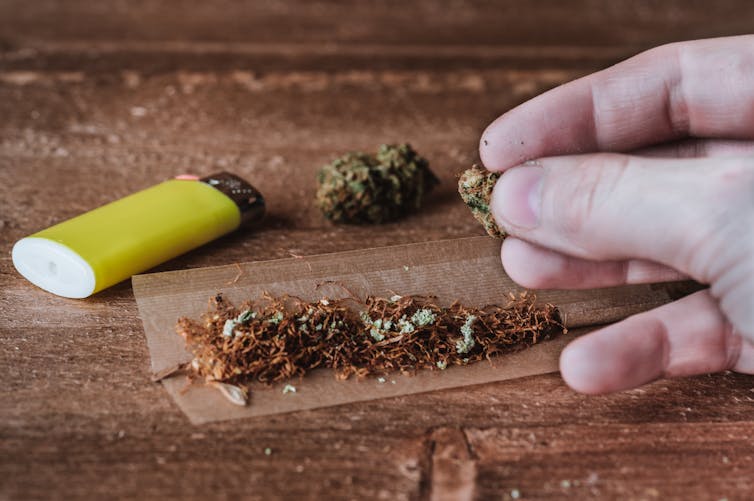Source: The Conversation (Au and NZ) – By Ranjodh B. Singh, Senior Lecturer, Curtin University

It’s no secret that many different drugs, whether illicit or regulated and legal, are often consumed together or share a similar group of users.
But the way people consume drugs together can vary, both with changes in their price and across different age groups.
Our recent research, published in the Journal of Population Economics, examined these dynamics between two of the most commonly used drugs in Australia – cannabis and tobacco.
We found younger people appear to use cannabis and tobacco together, meaning a rise in tobacco prices leads to a decrease in consumption of both tobacco and cannabis.
For those aged over 50, on the other hand, we see the opposite effect. Increasing the price of tobacco causes cannabis use to increase significantly.
These economic relationships are important to understand. Policies aimed at one drug can have unintended effects on the consumption of the other.
Complements or substitutes?
Drugs are often consumed in what’s called a “consumption bundle”, a combination of drugs a consumer chooses to purchase and consume. Tobacco and cannabis are one such bundle.
In 2023, 41% of Australians aged 14 and older reported having used cannabis at least once in their lifetime. About 2.5 million people reported consuming it in the past year.

Natali Brillianata
Tobacco use has seen a significant decline in Australia in recent decades, but vape and e-cigarette use has risen sharply, particularly among young people.
Like any two products, two different drugs in a consumption bundle can be described as complements (meaning they’re used together) or substitutes (they’re used in place of each other).
If the price of the first drug goes up and the demand for it falls, and demand for the second drug falls as well, the two drugs are complements.
If, however, a price increase for the first causes an increase in demand for the second drug, then the two drugs are substitutes.
Mixed messages
Much of the existing research on the economic relationship between tobacco and cannabis has suggested they are complements.
But other studies have suggested these drugs may have no such economic relationship, or could even be substitutes. Given these mixed results, our research aimed to investigate this phenomenon.
Our research hypothesis was that consumption patterns for cannabis and tobacco are likely to change with age, which could possibly explain these disparate findings.

nokturn/Shutterstock
Our research
Using data from the National Drug Strategy Household Survey (NDSHS) on just under 100,000 individuals, we modelled the relationship between cannabis consumption and tobacco price (along with numerous other factors).
Our model shows that when tobacco prices increase, cannabis consumption decreases for Australians under 40 years of age. For this age group, both drugs are complements.
For the age group 40 to 50, there is no evidence of any economic relationship between the two drugs.
However, for Australians aged 50 and over, increasing tobacco prices led to increased cannabis consumption. As such, both drugs are substitutes for this age group.
What might explain the difference?
Several factors may be contributing to the varying relationships between drugs across the age spectrum.
Younger users are less likely to be risk-averse, consuming drugs in bundles. They often roll cannabis and tobacco together in a joint “spliff” or “mulled cigarette”, using the two drugs as complements.
Older individuals, on the other hand, tend to be more risk-averse and consume a smaller drug bundle.
They may also self-impose some limits on the total amounts they consume, meaning an increase in the price of tobacco could increase cannabis consumption as a substitute.

wernimages/Shutterstock
Lessons for policymakers
Our findings can be used by policymakers and public health experts to estimate how cannabis consumption may change in response to changes in tobacco prices – and the possible unintended effects.
The government’s main lever for changing tobacco prices is the excise tax rate on tobacco. Australia’s excise rates are higher than in the US and UK, but lower than those of France, Finland and New Zealand.
Using our model, we conducted a simulation to assess the impact on cannabis comsumption if the price of tobacco was increased. The results suggest that across the entire population, a 10% increase in the price of tobacco would lead to about 240,000 fewer people consuming cannabis.
But this net decrease is a result of a substantial decrease of 340,000 for the under-40 age group and a modest increase of 68,000 for the over-50 age group. The remainder represents those aged 40 to 50.
![]()
The authors do not work for, consult, own shares in or receive funding from any company or organisation that would benefit from this article, and have disclosed no relevant affiliations beyond their academic appointment.
– ref. Are tobacco and cannabis economic substitutes or complements? New research suggests it changes with age – https://theconversation.com/are-tobacco-and-cannabis-economic-substitutes-or-complements-new-research-suggests-it-changes-with-age-245155








